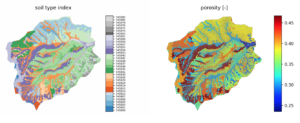River of data

Ethan Coon uses the Advanced Terrestrial Simulation code to model soil and water conditions in high resolution. These show various soil types (left) and porosities (right) mapped within the model’s mesh for the Coweeta Hydrologic Laboratory, a U.S. Forest Service research site in western North Carolina. (Image: Ethan Coon.)
When Oak Ridge National Laboratory scientist Ethan Coon takes his three kids into Tennessee’s wild areas, he’s sharing a lifelong passion for the outdoors. And in the process, Coon, a computational hydrologist, observes the flow of creeks and topography of hollows, informing his research to model, understand and ultimately protect watersheds.
“I went into grad school wanting to find a place where math could be applied to science problems that were relevant to societal concerns,” says Coon, a Columbia University graduate and a 2005-2009 Department of Energy Computational Science Graduate Fellowship (DOE CGSF) recipient. “I’ve been chasing that since then and the DOE labs have really allowed me to do that.”
The primary result of this personal mission is the Advanced Terrestrial Simulator (ATS), world-leading open-source software for the multiscale modeling of environmental issues in watersheds and related climate applications. A decade in the making – with a 14-person multidisciplinary core team across four DOE national laboratories – today ATS is used by research groups internationally, as well as for a variety of core-mission DOE research projects, and was awarded an R&D 100 award in 2020.
While leading ATS development, Coon has co-shepherded his career.
His Ph.D. research focused on using finite element methods for earthquake simulation. On reflection, he’s amazed at how the multiscale models he developed then – ones that excelled at integrating granular, subgrid-scale detail into computable approximations – have informed his ATS research. “It’s still math applied to earth sciences, just now water and climate,” says Coon, a scientist in ORNL’s Climate Change Science Institute and Earth Sciences Division.
As a postdoc and then research scientist at Los Alamos National Laboratory until joining ORNL in 2017, Coon was introduced to the code Amanzi (“water” in Zulu). It was developed as a multilab project beginning in the early 2000s to model how reactive contaminants move through groundwater in support DOE environmental site remediation. Coon harnessed Amanzi for another growing environmental concern: climate change.
“We took the math and code guts of Amanzi and used it to start to build up this capability around carbon released by melting Arctic permafrost, and it became the ATS,” Coon explains. The “A” in ATS wasn’t always for “advanced.” It originally stood for “Arctic.” As ATS applications were extended to temperate and even tropical environments, the A morphed with it.
“What makes ATS unique is its ability to scale the complexity up and down to meet the need” and for researchers to add or remove soil conditions or evapotranspiration and other physical properties, Coon says. Now researchers use ATS to model everything from post-fire hydrology to algal blooms and how climate change-related warming of water affects power plant cooling. “As rivers warm, that might become a limitation on energy production.”
A decade ago Coon mostly worked alone, writing the ATS code and thinking about the model physics. “Now the majority of my time is supporting scientists to use the ATS code and shape the conceptualization of that research into something that’s answerable with the code and the data.” Writing code, he notes, is largely relegated to his “pristine me time,” a couple of hours at night after the kids have been put to bed.
In 2021, Coon ran the first ATS user short course, a virtual event that attracted researchers from seven countries. This close collaboration with science users has benefitted ATS, guiding its development to focus on elements that are of concern to users, who create everything from simple one-dimensional models run on a researcher’s laptop to full 3D models using thousands of nodes on DOE supercomputers, including ORNL’s Summit. The result is that Coon is co-author with scientists from diverse disciplines on papers in journals ranging from Computational Geoscience to Water Resources Research and Environmental Research Letters.
The challenge of optimizing ATS for a range of computational platforms will grow increasingly important as Coon prepares it for the exascale era in his role as project integration lead in ExaSheds, a multi-institutional effort to model watersheds.
He’ll also continue to push the edge of ATS physics, including the long-standing challenge of “what humans mean in an earth systems model,” he says. In 2020, he and Christa Brelsford, his spouse and an ORNL colleague who specializes in social data for climate applications, characterized patterns of changes in impervious urban surfaces – asphalt and concrete. It’s a key issue with climate change-related urban flooding and was their first project together.
“There’s a lot of really important climate and water research and modeling that needs to happen to understand the impacts on society,” Coon says, “and especially to focus on adaptation and limiting the impact on the most vulnerable.”
Editor’s note: This article appears in the current issue of DEIXIS: The DOE CSGF Annual.
About the Author
Jacob Berkowitz is a science writer and author. His latest book is The Stardust Revolution: The New Story of Our Origin in the Stars.





